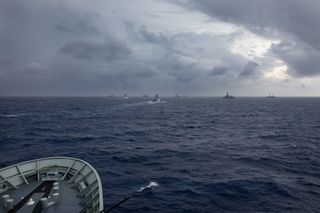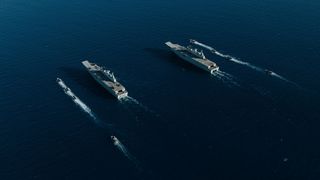It’s a gut-wrenching thing to contemplate a direct attack on Australia by the Chinese military. Even more so to be warned that if an attack takes place Australia could find itself abandoned by a United States that is unable or unwilling to defend us.
This is the stark picture Hugh White paints in his latest call for Australia to retool its military for a post-American region – a task he argues is so critical to our security that it warrants huge numbers of submarines, strike fighters and possibly nukes too.
But it’s an overly narrow scenario upon which to plan Australia’s defence strategy in an increasingly contested Indo-Pacific.
Failing to do so would not only shirk our regional responsibilities; it may hasten the arrival of the Hobbesian order that White and the rest of us are so worried about.
Instead of structuring our military around the defence of Australia, Canberra should accelerate efforts to build a collective regional approach to deter Chinese aggression at strategically pivotal flashpoints.
Failing to do so would not only shirk our regional responsibilities; it may hasten the arrival of the Hobbesian order that White and the rest of us are so worried about.
At the heart of all this is a trade-off between probability and severity.
Australian strategists must plan for worst-case scenarios. And, to be fair, no one can guarantee that White’s frightening prophecy won’t one day come true. Yet we must also consider what strategic challenges are most likely to arise – and weigh up the opportunity costs that Canberra will incur if it prioritises one set of future risks over another.
In this regard White’s focus is too narrow. Australia is incredibly unlikely to face the threat of a Chinese attack, particularly outside of a major war in which the regional order will have already been shattered.
By contrast, we’re extremely likely to witness intensifying Chinese challenges to the strategic status quo around Taiwan, the East China Sea, maritime south-east Asia and the Pacific. These flashpoints are where China is flexing its muscles, seeking to expand its geopolitical influence at America’s expense and to the detriment of our interests and those of our regional partners.

Future strategic order
It’s in these places that the Indo-Pacific’s future strategic order will be won or lost – not in the direct defence of Australia. And as America’s military dominance in the region is no longer assured, deterring China from gaining the upper hand in these tussles is not something that Washington can do alone.
This is why Canberra must contribute to regional defence tasks beyond our northern approaches, a mission that will require amphibious forces, drones and surface ships, as well as attack submarines, sophisticated fighters and other high-end assets.
Australia is incredibly unlikely to face the threat of a Chinese attack, particularly outside of a major war in which the regional order will have already been shattered.
By advancing a collective deterrence strategy with the US, Japan, South Korea, and key south-east Asian nations, Australia can play a valuable role in blunting Chinese aggression and minimising its strategic expansion. Not taking part would weaken this burgeoning coalition – making it more likely that others will also defect and, in turn, that China’s military influence will extend further afield.
This brings us back to defending Australia from Chinese attack.
Even if we do end up in this worst of all worlds, it’s not clear that a defence force built heavily around submarines, strike fighters and possible nukes would provide Australia with the flexibility it will require.
Given the trajectory of future warfare – and the extreme difficulty of moving large numbers of troops and materiel over the ocean uncontested – Beijing would likely choose offensive options that bypassed our geographic and maritime advantages.
These threats could include cyber operations targeting the critical infrastructure that supports our social and economic wellbeing, like transportation networks, energy grids and communications hubs. More should be invested in shoring up Australia’s digital defences for this eventuality and ensuring that we have a regionally superior offensive cyber capacity.
Powerful point of coercion
Space is another vulnerability. Targeting Australian satellites or denying our use of this global commons is a powerful point of coercion Beijing could press. Australia’s budding space industry and launch facilities, especially those in Northern Australia, could be bolstered to ensure adequate resiliency.
And if a direct kinetic attack on Australia were to occur, it would probably come in the form of long-range missile strikes by China’s Rocket Force against Australian or allied defence infrastructure. Working towards building integrated intelligence and surveillance assets, collective missile defences and developing our own stand-off strike capabilities should be a priority.
The future strategic landscape in the Indo-Pacific is likely to be more complex and contested than any we have previously lived through.
The future strategic landscape in the Indo-Pacific is likely to be more complex and contested than any we have previously lived through. Slimming Australia back to its defence fundamentals may be prudent for some tasks. But there is much more that Australia must do in sync with our regional allies and partners if we are to prop up a degenerating order before it comes crashing to our doorstep.







